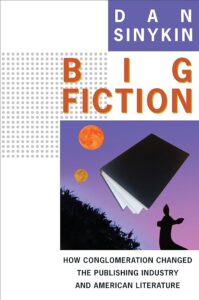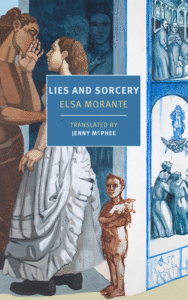
Our smorgasbord of sumptuous reviews this week includes Alexandra Jacobs on Barbra Streisand’s My Name is Barbra, Becca Rothfeld on Tracy K. Smith’s To Free the Captives, Kevin Lozano on Dan Sinykin’s Big Fiction, Fiona Maazel on Paul Auster’s Baumgartner, and Jess Bergman on Elsa Morante’s Lies and Sorcery.
“Of course Barbra Streisand’s memoir, 10 years in the making if you don’t count the chapter she scribbled in longhand in the 1990s and then lost, was going to approach Power Broker proportions … For one thing, she is—fits of insecurity notwithstanding—a bona fide power broker…For another, as Streisand writes in My Name Is Barbra, a 970-page victory lap past all who ever doubted, diminished or dissed her, with lingering high fives for the many supporters, she does tend to agonize over the editing process … There’s something exuberant and glorious, though, about Streisand’s photo dump of self-portraits and party pics. Indeed about this whole dragged-out banquet of a book. You might not have the appetite to linger for the whole thing, but you’ll find something worth a nosh. There are just so many scintillating Streisands to contemplate over so many years: singer, actress, director, producer, philanthropist, activist, lover, mother, wife, friend, autobiographer. ‘I would make a very good critic,’ she suggests at one point, and as I struggle to put a button on this, all I can reply is: Barbra, be my guest.”
–Alexandra Jacobs on Barbra Streisand’s My Name is Barbra (The New York Times)
“What if ghosts return not to haunt or hector, but because they cannot bear to relinquish the common pleasures of daily life? … Smith…writes prose at once dazzling and exacting. On nearly every page of this book is a phrase or sentence to marvel over, a word (usually an adjective) so unexpectedly apt that it freshens familiar language … So luscious that it often reads less like a collection of essays than like a work of prose poetry. Its six long sections and brief coda are not neatly contained narratives or discrete arguments, but threads in one continuous web of reminiscence and observation … Many of Smith’s flights of fancy are attempts to imagine all that the historical record conceals — to endow skeletal statistics with flesh and blood — and her lively lyricism is an antidote to the slick obfuscations of bureaucratic language. Over and over, she pits the dead rhetoric of institutions against the vibrant hum of human speech … Nothing could be less like institutional abstractions; nothing could be more lavishly particular.”
–Becca Rothfeld on Tracy K. Smith’s To Free the Captives (The Washington Post)

“That discomforting riddle—what these business machinations contribute to the actual publication of actual books—is the central question of Dan Sinykin’s Big Fiction...Sinykin argues that the corporate ethos that dominates the modern publishing house has exerted such an overwhelming influence on the way books are written and published that it has inaugurated a new epoch: ‘the Conglomerate era.’ As he sees it, the consolidation of the industry that began in the nineteen-sixties and seventies transformed American fiction and ‘changed what it means to be an author.’ The stakes of Sinykin’s inquiry are to explain ‘how we should read’ fiction published in the U.S. during the past half century or so, a period during which every book, no matter its preoccupations or themes, could be said to reflect a greater entity: the corporation … Today’s publishing house is closer to a hedge fund than a tastemaker. Every book that it acquires is a bet on profitability. The financialization of the acquisition process functions like an index of risk, creating a ‘system in which homogeneity . . . is encouraged’ to minimize bad bets … Sinykin sidesteps the question of whether this system has made books worse. He wants to demonstrate something trickier: how the process of authoring a book has become subsumed by a larger and larger network of interests, changing what it meant to be an author. Critics and scholars, Sinykin contends, are uncomfortable displacing the author when studying literature. His book is an earnest attempt to focus attention on the non-authorial figures involved in a book’s creation. Instead of individual writers, he wants us to think in terms of a ‘feedback loop’ .. The clumsiness of these readings points to the limitations of works like Big Fiction…These are daring attempts to map the larger structures that shape how books are written and published, but their attention to the big picture can obscure how novels operate on a visceral, textual level. Still, Sinykin’s study is valuable because it speaks to the same fear that Gerald Howard voiced in 1989: that the balance of culture and commerce at the heart of publishing is increasingly weighted toward profit.”
–Kevin Lozano on Dan Sinykin’s Big Fiction: How Conglomeration Changed the Publishing Industry and American Literature (The New Yorker)
“I can hear the whingeing already: Nothing happens in this novel. It’s too slow, it’s boring, it’s not high concept or high event. And in a nod to how conditioned we—or at least I—have become to expect high event, I spent the first 25 pages of Baumgartner waiting for its namesake to be kidnapped, maimed or just locked in a closet by the meter man. When it was clear this just wasn’t going to be that kind of novel, I had to start over. What kind of a novel is Baumgartner, then? It’s lovely. It’s sweet. It’s odd. But maybe not so odd for Auster fans who will immediately want to locate Baumgartner in his body of work (he’s written 20 novels) and to look for leitmotifs and signature moves. There are plenty…So it’s definitely a Paul Auster novel. Albeit more tender and less playful than some of his other work … The novel walks us through what he thinks about and, more important, how he thinks. How his thoughts assemble and fall apart, how they produce a kind of cumulative power that dissipates just as powerfully in the face of life’s little intrusions … Sy is old, lonely, frail, and his life is starred with these small events in a constellation that proves explosive enough on this morning to push him out of his emotional impasse. It also pushes the novel into gear to begin exploring and excavating Sy’s memories … There are a lot of books out there about grief, and it’s hard to say what kind of conversation Baumgartner is having with them—every grief is its own. Still, Sy’s experience puts me in mind of C.S. Lewis, who at 61 lost his wife to cancer, and who wrote about the loss in A Grief Observed...As Lewis put it: ‘Grief is like a long valley, a winding valley where any bend may reveal a totally new landscape.’ Baumgartner, for its quiet and thoughtful meandering, reads the same way.”
–Fiona Maazel on Paul Auster’s Baumgartner (The New York Times Book Review)

“At the time the novel was published, Italian literary culture revolved around neorealism. The practitioners of this style…spurned elegance, artifice, and the pomposity of Fascist propaganda, using plain language to convey the devastation of the war and the fractured society it left behind. Lies and Sorcery is in many ways neorealism’s inverse. The novel, a melodramatic saga of social climbing and doomed romance, is a deliberate anachronism in both its themes and its style. Its Belle Époque setting, sweeping cast of characters, frequent asides to the reader, and grandiloquence place it firmly in the tradition of the nineteenth-century novel. It is not concerned with truth but with lies: glittering surfaces, concealed identities, and foolish pretensions. As Morante reminds us again and again, however, appearances are often deceiving. Despite its nineteenth-century veneer, Lies and Sorcery could have only been written in the twentieth century. The novel is animated by Morante’s hatred of the selfishness and superficiality that she saw in her countrymen. In their masochistic worship of hierarchy, tendency toward idolatry, and susceptibility to kitsch, its characters embody the traits that she believed had enabled Mussolini’s rise.”
–Jess Bergman on Elsa Morante’s Lies and Sorcery (The New Yorker)

